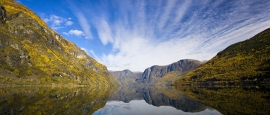Weather in Nairobi
Nairobi sits at an elevation of 1,795m (5,889ft) and some 200km (124 miles) below the Equator, enjoying a moderate climate with average temperatures fluctuating between 17°C (63°F) to 21°C (70°F) year round.
January and February are a good time to visit Nairobi as they are relatively dry, with rainfall averaging 50mm (2 inches) and plenty of sunshine.
The months of March to May contain the long rainy season, making it a gloomy time to visit. April is the wettest month, averaging 130mm (5.1 inches) of rain, and it does not ease up until June.
July, August, September and October are peak tourist season in Nairobi. During this time the skies are clear, and wildlife is easy to spot among the dry grass in the national parks. Many safari enthusiasts use this time to start their trip from Nairobi to Masai Mara, hoping to catch a glimpse of some of the thousands of wildebeest and zebra migrating from June to October.
November and December contain the short rainy season, the downpour turning the city lush and green once again.
Night
| Weather (night) | Temp (min night) | Rain (mm) | Wind (mph) | Humidity Pressure Visibility | ||
|---|---|---|---|---|---|---|
| Sun |
Partly Cloudy Night
|
Partly cloudy skies |
1 6 °C |
1.9mm |
4
ene |
80%
1,018mb Good |
| Mon |
Partly Cloudy Night
|
Partly cloudy skies |
1 6 °C |
2mm |
6
e |
77%
1,017mb Good |
| Tue |
Partly Cloudy Night
|
Partly cloudy skies |
1 7 °C |
2.1mm |
6
e |
76%
1,018mb Good |
| Wed |
Partly Cloudy Night
|
Partly cloudy skies |
1 7 °C |
1.3mm |
8
e |
79%
1,017mb Good |
| Thu |
Cloudy
|
Cloudy skies |
1 7 °C |
0.5mm |
6
e |
80%
1,016mb Good |
| Fri |
Partly Cloudy Night
|
Partly cloudy skies |
1 8 °C |
0.4mm |
7
e |
83%
1,015mb Good |
| Sat |
Partly Cloudy Night
|
Partly cloudy skies |
1 8 °C |
0.3mm |
8
ene |
77%
1,015mb Good |
| Sun |
Clear
|
Clear skies |
1 9 °C |
2mm |
12
ese |
49%
1,013mb Good |
| Mon |
Clear
|
Clear skies |
1 8 °C |
0.3mm |
9
e |
47%
1,013mb Good |
- 0 to 30 is very low
- 31 to 50 is low
- 51 to 70 is moderate to low
- 71 to 80 is moderate
- 81 to 90 is moderate to high
- 91 to 100 is high
- Very poor - less than 1km
- Poor - between 1km and 4km
- Moderate - between 4km and 10km
- Good - between 10km and 20km
- Very good - between 20km and 40km
- Excellent - more than 40km
Temperature in Nairobi
Sunlight in Nairobi
Precipitation in Nairobi
Humidity in Nairobi
Do you have any Feedback about this page?
© 2025 Columbus Travel Media Ltd. All rights reserved. No part of this site may be reproduced without our written permission, click here for information on Columbus Content Solutions.








 You know where
You know where